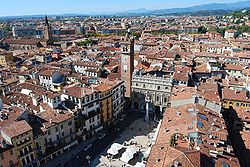Verona
| Verona | ||
|---|---|---|
| Comune | ||
| Città di Verona | ||

A collage of Verona, clockwise from top left to right: View of Piazza Bra from Verona Arena, House of Juliet, Verona Arena, Ponte Pietra at sunset, Statue of Madonna Verona's fountain in Piazza Erbe, view of Piazza Erbe from Lamberti Tower
|
||
|
||
| Location of Verona in Italy | ||
| Coordinates: 45°26′N 10°59′E / 45.433°N 10.983°ECoordinates: 45°26′N 10°59′E / 45.433°N 10.983°E | ||
| Country | Italy | |
| Region | Veneto | |
| Province / Metropolitan city | Verona (VR) | |
| Frazioni | Avesa, San Michele Extra, San Massimo all'Adige, Quinzano, Quinto di Valpantena, Poiano di Valpantena, Parona di Valpolicella, Montorio Veronese, Mizzole, Marchesino, Chievo, Cà di David e Moruri | |
| Government | ||
| • Mayor | Flavio Tosi | |
| Area | ||
| • Total | 206.63 km2 (79.78 sq mi) | |
| Elevation | 59 m (194 ft) | |
| Population (2015) | ||
| • Total | 259,069 | |
| • Density | 1,300/km2 (3,200/sq mi) | |
| Demonym(s) | Veronesi or Scaligeri | |
| Time zone | CET (UTC+1) | |
| • Summer (DST) | CEST (UTC+2) | |
| Postal code | 37100 | |
| Dialing code | 045 | |
| Patron saint | Saint Zeno of Verona | |
| Saint day | 12 April | |
| Website | Official website | |
| City of Verona | |
|---|---|
| Name as inscribed on the World Heritage List | |
 |
|
| Location | Italy |
| Type | Cultural |
| Criteria | ii, iv |
| Reference | 797 |
| UNESCO region | Europe and North America |
| Inscription history | |
| Inscription | 2000 (24th Session) |
| 2012 largest resident foreign-born groups | |
|---|---|
| Country of birth | Population |
|
|
7,109 |
|
|
5,648 |
|
|
3,436 |
|
|
1,757 |
|
|
1,691 |
|
|
1,617 |
|
|
1,467 |
|
|
1,138 |
Verona (Italian pronunciation: [veˈroːna]; Venetian: Verona, Veròna) is a city on the Adige river in Veneto, northern Italy, with approximately 265,000 inhabitants and one of the seven provincial capitals of the region. It is the second largest city municipality in the region and the third largest in northeast Italy. The metropolitan area of Verona covers an area of 1,426 km2 (550.58 sq mi) and has a population of 714,274 inhabitants. It is one of the main tourist destinations in northern Italy, owing to its artistic heritage, several annual fairs, shows, and operas, such as the lyrical season in the Arena, the ancient amphitheatre built by the Romans.
Three of Shakespeare's plays are set in Verona: Romeo and Juliet, The Two Gentlemen of Verona, and The Taming of the Shrew. It is unknown if Shakespeare ever visited Verona or Italy at all, but his plays have lured many visitors to Verona and surrounding cities many times over. The city has been awarded World Heritage Site status by UNESCO because of its urban structure and architecture.
The etymology of the name "Verona" is unknown. It may be derived from Vera, perhaps an Etruscan person's name; or it might be of Gallic origin; it may be the name of a Roman family or come from the Latin "ver", meaning "spring". But according to one legend the legendary founder of the city, the Gallic chieftain Brenno, called the new inhabited centre "Vae Roma", that is "Accursed Rome", which then over the centuries became Verona.
Another theory is that it is connected to the river. "Vera" was a name of the river Adige before the adoption of the current name. As in many similar instances in Europe the name of the town is formed with the addition of suffix -ona which means settlement over.
...
Wikipedia


